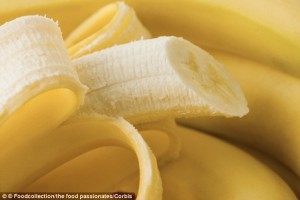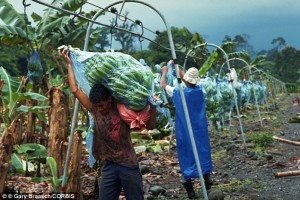
- Fungus is called Fusarium oxysporum f.sp. cubense or Panama disease
- Since its discovery, the disease had been largely concentrated in Taiwan
- However, it has recently wiped out plantations in Indonesia and Malaysia
- Experts warn the disease could cause Cavendish bananas to go extinct
Your fruit bowl could soon look a lot less colourful due to a virulent strain of fungus threatening the world’s banana plantations.
The fungus is called Fusarium oxysporum f.sp. cubense, or Panama disease, and it has already destroyed crops in Taiwan, Indonesia and Malaysia.
Experts are now warning it is ‘only a matter of time’ before the disease reaches Latin America where the majority of exported bananas found in our supermarkets are grown.
 Researchers from Wageningen University in the Netherlands have plotted the spread of the disease since its origins in East Asia.
Researchers from Wageningen University in the Netherlands have plotted the spread of the disease since its origins in East Asia.
They discovered that a clone of the Panama disease called Tropical Race 4 is a specific threat to the Cavendish banana.
Cavendish bananas account for more than 47 per cent of global banana production and exports.
TR4 was found in Indonesia before it spread to Taiwan, China and Southeast Asia.
The disease causes the plants to wilt by targeting its vascular system and by reducing the amount of water it takes in from the soil.
The researchers found there was a significant decline in exports in these affected regions.
The fungus is currently impervious to treatment and the study found the fungus has spread to Pakistan, Lebanon, Jordan, Oman, Mozambique, and Queensland.
In 1876, a wilting disease of banana was reported in Australia, and in 1890, it was observed in the ‘Gros Michel’ plantation crops of Costa Rica and Panama.
There it developed major epidemics in the 1900s that the researchers described as ‘among the worst in agricultural history’.
It was only in 1910 that the soil-borne fungus Fusarium oxysporum f.sp. cubense (Foc) was identified as the cause in Cuba.
‘TR4 may have affected up to approximately 100,000 hectares, and it is likely that it will disseminate further – either through infected plant material, contaminated soil, tools, or footwear, or due to flooding and inappropriate sanitation measures,’ explained the researchers.
‘Clearly, the current expansion of the Panama disease epidemic is particularly destructive due to the massive monoculture of susceptible Cavendish bananas.
The paper, Worse Comes to Worst: Bananas and Panama Disease – When Plant and Pathogen Clones Meet, is published in the journal Plos One.